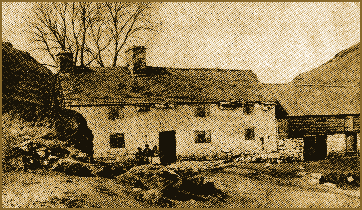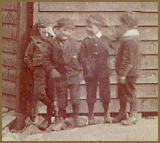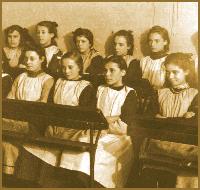A BRIEF HISTORY OF
EDUCATION IN WALESEDUCATION IN WALES 1
The origins of education
During the Middle Ages the vast majority of the population had no access to any kind of education. Only the sons of the property owning classes could afford to attend the few schools which did exist and go on to Oxford or Cambridge, or enter the Church or the legal profession.By the sixteenth century the expanding trading classes wanted an education for their sons and a number of grammar schools were set up to meet the new demand, some created, like Christ's College, Brecon, by the church, and some, like John Beddoes' school in Presteigne, endowed by successful local businessmen.
The Welsh Trust and SPCK
During the period of the rule of Parliament following the death of Charles 1, attempts were made to create a system of education open to a wider section of society and sixty "free schools" were founded in Wales. Although little is known about these schools and they were swept away at the Restoration of the monarchy, they did demonstrate new possibilities. Thomas Gouge of London established a fund in 1674 to help set up Welsh language schools across Wales which taught basic literacy through the Bible and religious texts according to Anglican principles. He also created the Welsh Trust to publish books in support of these aims. Some 300 schools were created in this way.In 1699 four men including Cardiganshire MP, Sir Humphrey Mackworth, established the Society for the Promotion of Christian Knowledge, (SPCK) which set up a nation-wide network of Anglican charity schools across Wales. Teaching was in both English and Welsh and the SPCK published and made widely available a Welsh Bible. As well as basic literacy and the catechism, boys were taught arithmetic and girls needlework, spinning and weaving. Although the schools were set up in a wide variety of buildings, annual inspections kept the standards to a high level.
EDUCATION IN WALES 2
Circulating Schools
Griffith Jones of Penboyr in Dyfed founded the Circulating School movement in Wales as a way of reaching a greater number of children. While curate at Laugharne he became a teacher at the SPCK school there and continued his involvement in education when made rector of Llanddowror. He established a school in the village in 1731, and then began to develop his ideas of establishing further small village schools to be run by itinerant teachers who would spend three months establishing the school, and then move on.The idea proved hugely successful and it has been estimated that around 3,500 schools had been set up by the time of Griffith Jones' death in 1761. Again, teaching was mainly basic literacy through religious texts provided by the SPCK and charitable funds were spent on the teaching and not on buildings. Schools were run in barns and storehouses and, in one case, a windmill. By the end of the century problems with securing adequate charitable funding caused the movement to peter out, but not before an appetite for learning had been created. (The history on the Circulating School movement is dealt with in more detail in this section of the website, or click HERE.)
Sunday Schools
Despite the success of these measures, many parts of Wales were not reached by them or were visited by a circulating school which lasted only a few months before the teacher moved on.
Into this vacuum came the Sunday Schools. This was an idea first tried in England and seized upon by the rapidly growing Nonconformist sects in Wales. Here classes were held on the day most people were available and were open to adults and children alike.
Again, basic tuition in reading and writing was based on the scriptures. The success of the movement led to its adoption by all denominations and a publishing industry grew to satisfy its need for texts. At first the schools were held in houses and barns. Later they were often held in purpose-built Sunday school buildings alongside churches and chapels.
The Sunday Schools created a huge impetus towards universal education and gave huge support to the Welsh language, but once state education was established their role remained religious and therefore peripheral to the main thrust of education in Wales.
EDUCATION IN WALES 3 (1811-1847)
The founding of the Societies
The National Society was established in 1811 to set up schools in which the children of the poor would be taught the Anglican religion. The British and Foreign Society was established in 1814 to promote non-sectarian education. At the time there was no state funding of education, and these schools were dependent on voluntary contributions. However, the National Society had an advantage in benefiting from the Anglican diocesan system, and also from the readiness of landowners to endow Anglican education. Therefore by 1833 (when the government made the first state contribution to the funding of schools) there were 146 National schools in Wales as opposed to just some 15 British schools. This did not reflect the growing numbers involved in Nonconformity, and many Nonconformist parents refused to allow their children to attend the Church schools.First moves towards state involvement
In 1833 the government began to contribute towards the cost of erecting schools. It was decided to share the money between the National Society and the British Society. The National Society was better organised to take advantage of this, and during the period 1833-47 a further 231 National schools were established in Wales. In 1843 Sir Robert Peel's Tory government tried to introduce a bill to establish schools for the children of the poor. But according to the proposals, the boards which would have been set up to supervise them would have had an Anglican majority, and in the face of Nonconformist protests (from both Protestants and Catholics) the measure was withdrawn.The Nonconformists in Wales had been slow to take advantage of government grants to establish British schools since 1833 (by 1843 there were still only 28 British schools in Wales). But now more rapid progress was made, and by 1847another 79 had been established, mainly in the north and west.
EDUCATION IN WALES 4 (1847-1870)
The infamous "Blue Books"
In 1847 a commission (consisting of Anglican Englishmen) to look into the state of Welsh education reported back, in what became known as the "Treachery of the Blue Books". This was a fairly damning indictment but also a very detailed one which recognised the class and religious divides which hampered progress in education in Wales. Unfortunately, it also made some severe generalisations along racial and moral lines which outraged the Nonconformists and led to a further alienation from Anglicanism.By a Revised Code of Regulations, from 1862 the head teachers of all schools receiving a grant were required to make a daily entry in a School Log Book, an invaluable source reflecting the life of a school.
The School Boards
By 1870 the British Society (i.e. Nonconformist) had some 300 schools in Wales, but the National Society (i.e. Anglican) had over 1,000. The Liberal government now tried to create a comprehensive network of elementary schools in Wales, and also attempted to get round the unwillingness of Anglicans and Nonconformists to compromise over religion (which Peel had failed to do in 1843). This was the Education Act of 1870, which provided for a full education for lower-class children up to the age of 13.Government grants would continue to British and National schools, but where provision was inadequate, a School Board was to be set up to build a Board school which would be funded by the rates.
The board was to determine whether or not there should be religious education in its schools, but such education, if given, was not to be denominational: however, under Clause 25 of the Act, the boards were empowered to pay the fees of poor children attending denominational schools.
The British schools were incorporated into the School Board system, but the (Anglican) National and Roman Catholic schools preferred to stay outside. This meant that they received no financial assistance from the rates.
Controversially, no Board schools were set up where there was sufficient National school provision, even if most of the children in the area came from Nonconformist families. This was a source of grievance to Nonconformists. On the other hand, about half of the 320 Board schools in Wales opted for no religious teaching at all.
EDUCATION IN WALES 5 (1870-1902)
Universal education established
In 1876 the principle was established that all children should receive an elementary education, and parents were to be liable for the attendance of their children. The Education Act, 1876 also recommended setting up school attendance committees to enforce more regular attendance. By the Education Act, 1880, school attendance to the age of ten was made compulsory. Children could leave school at ten, but could also be required to stay on if their attendance had not been satisfactory.The appearance of county councils in 1889 heralded the next development in education in Wales. The Welsh Intermediate Education Act of 1889 established county joint education committees, the majority of whose members were to be councillors. (The act was a private measure by Stuart Rendel, Liberal M.P. for Montgomeryshire 1880-1894 and a close personal friend of Gladstone.) The joint committees were to draw up plans for county schools (later grammar schools) to be financed from a combination of the rates, a treasury grant, fees from pupils and the reorganisation of old endowments. This was the first time that public money was spent on specifically Welsh intermediate education and it provided education supported by the rates earlier than in England. Many of the old, endowed schools, chose to be part of the new system but others – including Brecon – remained outside. In matters relating to examinations and inspections they were answerable to the Central Welsh Board, established in 1896.
Local Education Authorities
On 1 September 1891 elementary education became free of charge. In 1893 the school leaving age was raised to eleven, and in 1899 it was raised again to twelve. Under Balfour's Education Act, 1902, School Boards were abolished and Local Education Authorities were established. The Education Committees of county councils were made responsible for elementary and intermediate schools (the act called Church schools "Non Provided schools" and called Board schools "Provided schools"). But the measure was intended in part by the Conservative government to safeguard the future of the Church schools, which had received no funding from the rates (unlike the Board schools since 1870). The Nonconformists had hoped that the Church schools would gradually disappear for lack of funds, but now they would receive funding from the rates too – and since Church schools were often the only ones available in an area it meant that Nonconformist children would have to continue to attend Anglican schools.EDUCATION IN WALES 6 (1902-1970)
The Coercion of Wales Act
The local authorities demanded absolute control over the Non Provided (Church) schools and an end to religious tests for teachers. By 1904, only Breconshire and Radnorshire out of all the counties of Wales were prepared to implement the 1902 Act, and give rate aid to Non Provided schools. But after the local council elections in May they fell into line with all the other councils in Wales and refused to implement it.The government responded with the Education (Local Authority Default) Act, 1905, also known as the "Coercion of Wales Act". The Conservative government under Balfour fell in December 1905 and Campbell-Bannerman's Liberals came to power. The new government withdrew the "Coercion Act".
Secondary Education for all
In 1918 the school leaving age was raised to 14. By R.A. Butler's Education Act of 1944 every effort was made to ensure that every child should attend a secondary school without having to pay fees. Following the act the school leaving age was raised again, to 15. The Eleven Plus examination was retained: those who passed went to grammar schools, and secondary "modern" schools were built to educate those who failed. (Before the 1944 Act, those who failed the Eleven Plus had had to stay on at junior school.)In 1969 the school leaving age was raised (for the last time?) to 16.
The Labour government of 1974-79 abolished the distinction between grammar and secondary modern schools and by the end of the 1970s the Eleven Plus was almost gone in Wales.
Year Comments 1880 First time school leaving age made compulsory 1891 Elementary education becomes free of charge 1893 . 1899 . 1918 . 1944 The 'Butler' Education Act OF 1944 makes secondary education free for all and is implemented by the Labour government elected in 1945. 1969 . 2008 Introduced from September 2008 Source: http://history.powys.org.uk/history/common/educ6.html
(with the table of school leaving ages complied for this site)A SUMMARY OF THE MAIN EDUCATION ACTS, 1870 - 1944
Education as we would recognise it today came about with various nineteenth century Acts of Parliament, empowering (and, in part, funding) local bodies to establish schools. Before this, school provision was either privately funded (and therefore only available to the wealthy) or run by local churches. By far the most important of these government provisions was the 1870 Education Act, amended several times by later Acts of Parliament.
The 1870 Education Act
This was prompted by the extension of voting rights, the collapse of non-conformist voluntary education, and the foundation of the national Education League in 1869. Britain was divided into school districts; where the education department found existing provisions to be inadequate, school boards were elected and given powers to levy rates and build schools. School fees continued, though school boards were empowered to establish free schools.The 1902 Education Act
This act was designed to streamline educational administration by transferring the function of the school boards to county and borough councils. For the first time they were given the power to establish secondary schools (the publicly funded schools before this were primary schools for children under twelve only). The most controversial feature was the establishment of local authority maintenance of voluntary schools, which aroused the wrath of Nonconformists who objected to subsidising Anglican educationThe 1918 Education Act
This was promoted by H. A. l. Fisher, the president of the Board of Education in the war-time coalition government. It gave the board powers to compel the local authorities to make adequate provision for education and, in return, the state to provide financial aid. They envisaged the establishment of nursery education, continuing education and more senior schools, but the first two became victims of the post-war retrenchment. The act ended the half-time system and introduced 14 as the minimum leaving age, with some provisions made for a part-time, after-school education scheme.The 1944 Education Act
This was known as Butler's Act after the Conservative President of the Board of Education. Its most significant feature was making it compulsory on the part of local authorities to provide secondary education. The Act raised the school leaving age to 15 and the age limit for the part time education scheme to 18, though the latter wasn't implemented. Local authorities were able to provide school meals, free milk and a regular medical examination. The Act also gave religious instruction a firm basis in schools, requiring them to take part in a daily act of collective worship. The Butler Act was implemented when a Labour Government was elected to power in 1945.Date this page last updated: October 1, 2010



